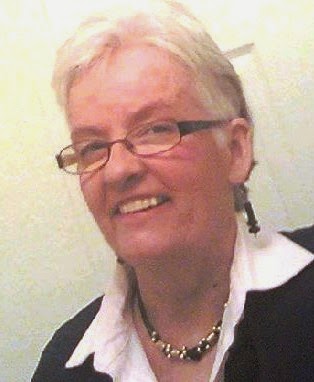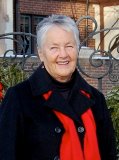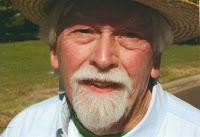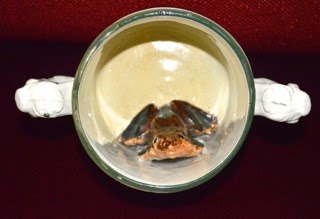us here did, in the nineteen-thirties or ‘forties, practically every figure of
influence and power, from God to Santa Claus, was male. Oh sure there was Mom,
and maybe some other female family members; even possibly a teacher, nurse, or
some kind of social worker in the traditionally female nurturing/caring roles.
But the police, firemen, ministers, lawyers, doctors, drivers, sports figures,
business owners, politicians, bankers, musicians and artists, etc etc, were
almost exclusively male, with one or two rare exceptions.
Women in My Life came up, I expected to bore you all some more with ravings
about My Beautiful Betsy – and not that she is not deserving of it – but a
couple of weeks ago the topic Sports brought me to a different approach. Many
women talked about the bond they had developed with their fathers over sports.
Or maybe it was the bond they had developed with sports through their fathers!
And not to denigrate father-daughter relationships, but I was struck by the
lack of mothers or even grandmothers. They simply did not figure. They were not
there. So I am going to talk about the leitmotif which seems to have followed
me – Women (not) in My Life.
my mother, but in case anyone has been woefully remiss and not memorized every
word I’ve ever written, I’ll repeat it briefly as she was the first woman who
was not in my life; not in the way I wanted and needed her to be, at least.
There was some unidentifiable something that came between us. It left a
gap; a space. She wasn’t with me. Children intuit things but cannot
possibly explain them, even to themselves. Much later in my life, a
psychiatrist interpreted this all for me and I think she had got it right. It feels
right to me.
my parents had had two children who died before I was born. At ages I think two
and three, they died of meningitis in 1940. My mother, the therapist
postulated, could not bare the prospect of a repeat of such pain, so she didn’t
allow herself to be as close to me as she doubtless would have been otherwise.
That explained so much. I loved my mother and she loved me. I was never in
doubt of that, but nevertheless she was, in some sense, not in my life.
remember, decades before I came out even to myself, I have always been in love
with some female figure in my life. Only one at a time. Even in my fantasy
world I was seriously, if serially, monogamous. They were wonderful friends but
were never in my life the way I wished they were; needed them to be. Of
course I only recognized this at some deeply buried subliminal level, so I
didn’t even give them the chance to be what I only dreamed of. Those with whom
I am still in contact were, when I told them of my long-ago love, flattered
rather than horrified. I seem to have chosen wisely, these women who were not
in my life!
met a lesbian who was not at some stage in love with her gym teacher. I am no
exception. But I was a pudgy un-athletic child who did not impress her at all.
field hockey and tennis teams only because it was a very small school requiring
all hands to the wheel. I enjoyed both, probably mostly due to my infatuation,
lapping up her gentle criticism as I would have praise from my other teachers.
When she married the geography teacher I was broken hearted, but then she never
was really in my life.
certain female role models absent in the U.S. When I was nine, the king died
and Queen Elizabeth ascended the throne. She’s been there ever since and seems,
as I’m sure it must to Prince Charles, destined to live forever. Previous
queens, Elizabeth the First and Victoria, lived long and reigned well. Women in
power were nothing new. But they had been born to it. That’s the only way you
get there! You don’t think, as a “commoner” in Britain, maybe I
should work towards being queen when I grow up!
admire the position she had; the power she had taken. But her politics were not
mine. The family I had still remaining in Britain despised her. She was a role
model in some sense, perhaps, but she was not in my life: nor would I want her
to be.
artists of the day were overwhelmingly male. Come on, I know you can rattle off
half a dozen world-famous male landscape or portrait painters. How many women
can you name?
a-changing!
in the U.S. were women. Now the number is over 30%, with women making up half
of the students in Medical School. The percentage of women in the legal
profession these days is much the same. After the recent mid-term election,
there will be more women in Congress than ever before. (One of the few good
things to come from that election, sadly) There is no longer any shortage of
women athletes. When I grew up, we would have considered it a joke if anyone
had prophesied that within our lifetimes we would watch women’s teams competing
in soccer, and all the way up to the Olympics. Coaching is rather a different
story. Many women, in teams or in individual sports, employ male rather than
female coaches, something I find hard to understand. Many in individual sports
are coached by their fathers, but only occasionally by mothers. And as for
women coaching men, well……. But there are a few examples even of that, one
very notable. Brit. tennis champion Andy Murray, winner of Wimbledon and an
Olympic gold medal, was originally coached by his mother and is currently
coached by Amelie Mauresmo, an openly lesbian French tennis champion. Some
changes are slow in coming. Women currently hold only 5% of Fortune 500
companies’ CEO positions. But it will come. Hard as the Republicans might try
to push women’s rights back into the Dark Ages, I cannot believe they will
succeed. We have come too far and fought too long to go back now.
women (not) in my life, but they are in fact still with me, if in some cases only
in memory, and the relationship I have with them now is genuine, real, in a way
it never could be before. One of the women I was madly in love with for years,
remains my closest friend as she has been for almost fifty years. We love each
other like sisters and there are no longer all those confused emotions on my
part to complicate our love. My mother is still with me. She always will be. I
hear her chuckle at some silliness – she had a great sense of humor. And now at
least I have a little understanding of the flaw in our relationship, and the
reason for it, I accept that it was not about me, so I am free of the
many negative, confused, emotions it once visited upon me.
is that of Brunhilda! She, as most of you know, was our VW camper van which we
drove over 100,000 miles around this country. She, Betsy, and I, had a little menage
a trois for 15 years. Sadly the old girl got battered and worn out and way
too expensive to maintain so it was time to say goodbye. But the story ends
happily. She went to live with a man who restores these beasts. So after a
while, with new hips and knees and a heart transplant, she’ll be in better
shape than any of us. And perhaps, as she remains with us only in memory, we
will learn in fact to love her more. Because in real time there were more than
a few occasions when I came close to wishing she was one of those women (not)
join my life. It was something of a stormy relationship, to say the least! Now
we can just gaze fondly at our photographs and see her through those
rose-colored glasses we all tend to favor as the years go by. And all those
women once (not) in my life slide quietly into their correct, comfortable, and
comforting, places, whether in my life or only in my memory.
the Author
was born and raised in England. After graduation from college there, I moved to
the U.S. and, having discovered Colorado, never left. I have lived in the
Denver-Boulder area since 1965, working for 30 years at IBM. I married, raised
four stepchildren, then got divorced after finally, in my forties, accepting
myself as a lesbian. I have now been with my wonderful partner Betsy for 25
years.












